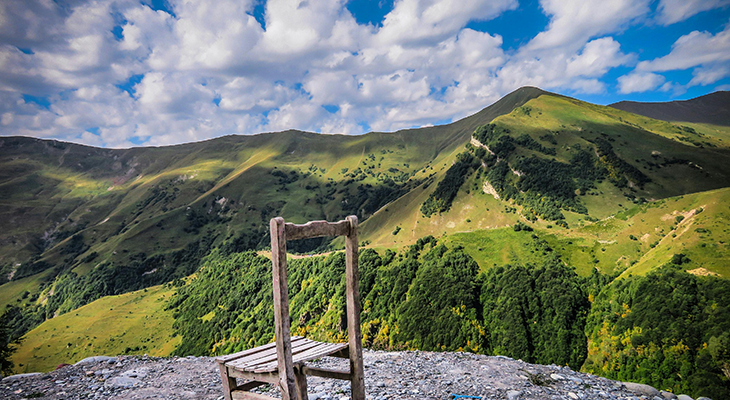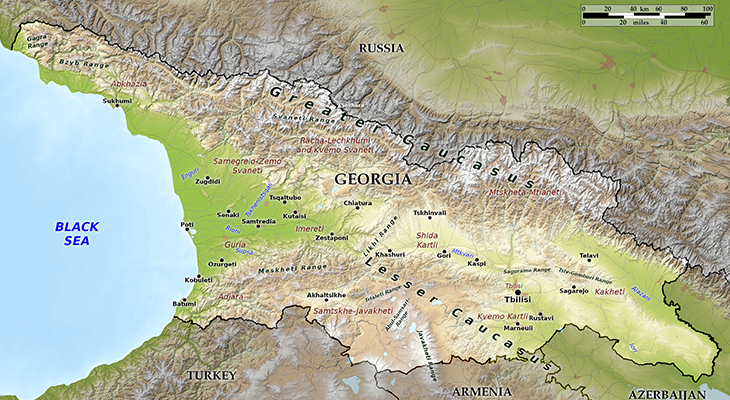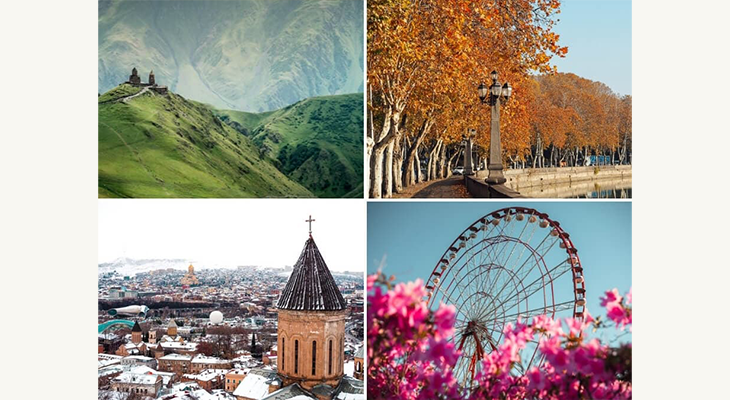Travel to Georgia: Complete 2025 Guide to the Caucasus Gem
Balanced, in‑depth handbook for every traveler: wine valleys, mountain towers, Black Sea boulevards, cuisine & culture everything you need to confidently travel to Georgia.

Quick visual primer before you travel to Georgia: regions, food, wine & itinerary flow.
Table of Contents
- Visa & Entry Essentials
- Safety & Responsible Travel
- Tourism Snapshot & 2025 Outlook
- Regions at a Glance
- Tbilisi: Capital Culture Hub
- Wine Country & Kakheti Experiences
- Mountain Adventures: Svaneti & Kazbegi
- Black Sea & Batumi Coastline
- Winter Sports & Gudauri Skiing
- Georgian Cuisine & Culinary Travel
- Transport & Getting Around
- Sample 7‑Day & 14‑Day Itineraries
- Costs, Budgeting & Money Tips
- Digital Nomad & Remote Work Considerations
- Sustainable & Ethical Travel Practices
- Festivals, Culture & Etiquette
- Unique / Niche Experiences
- Quick Takeaways
- Conclusion
- FAQs
Cradled between the Caucasus Mountains and the Black Sea, Georgia blends snow‑tipped peaks, medieval stone towers, 8,000‑year wine traditions, seaside boulevards, ski resorts, and a dynamic food culture that doubles as an expression of national identity making travel to Georgia one of 2025’s most rewarding decisions. Tourism recovery continues, with millions of arrivals and a projected climb in both visitors and revenue, helped by improved regional connectivity and evolving visa policies.
Travel planners balance easy metro and bus networks in Tbilisi, emerging digital‑nomad appeal, year‑round adventure (from Gudauri ski slopes to Batumi’s subtropical coast), and a cuisine where khachapuri and qvevri wine act as edible storytelling. This guide distills current entry rules, safety advisories, regional highlights, transport, seasonal itineraries, cultural etiquette, sustainable practices, budgeting, and niche experiences adding unique insights (like “micro‑loop” itineraries and taste sequencing for wine‑food pairings) that typical listicles skip so you can confidently shape your own narrative when you travel to Georgia.
1. Visa & Entry Essentials
Georgia maintains a comparatively liberal entry stance, offering visa‑free access to many nationalities, and an e‑Visa system for others; recent policy adjustments introduced new stay limits for specific national groups always re‑check shortly before you travel to Georgia.
Travelers not visa‑exempt can apply remotely via the official e‑Visa portal (application from outside Georgia; site enumerates documentation and nationality eligibility).
Certain travelers still use consular channels for short‑term visas, so distinguishing between e‑Visa eligibility and standard consular routes is critical.
Unique Insight
Create a dual compliance folder (secure cloud + printed) with bio page, onward ticket, accommodation proof, optional insurance summary; it speeds secondary checks and reduces stress during multi‑country Caucasus travel.
2. Safety & Responsible Travel
Overall advisory levels generally recommend normal precautions nationwide while identifying elevated risk zones South Ossetia and Abkhazia due to crime, civil unrest, and landmines; avoid these areas when you travel to Georgia.
Register with your embassy, enable travel alerts, maintain situational awareness, and keep backups of documents offline for resilience in a dynamic geopolitical corridor.
Unique Insight
Geo‑fence no‑go coordinates (South Ossetia, Abkhazia) inside offline map apps so your routing never accidentally suggests crossing restricted areas an overlooked digital safety layer.
3. Tourism Snapshot & 2025 Outlook
Recent multi‑million arrival figures show ongoing recovery momentum; early 2025 data reflects incremental growth over the prior year, signaling strengthened confidence in travel to Georgia.
Analysts project 2025 arrivals surpassing 5.1–5.3 million with modest revenue uplift; diversification toward Middle Eastern and Asian source markets adds resilience.
Long‑term ambitions envision double‑digit million visitor counts mid‑decade, implying future infrastructure load and sustainability trade‑offs travelers should anticipate.
Unique Insight
Adopt “micro‑loop” routing pair iconic sites with nearby lesser‑known towns to diffuse crowd pressure and support dispersed local economies while you travel to Georgia.
4. Regions at a Glance
Georgia’s compact size hides dramatic contrasts: alpine Svaneti’s defensive towers, Kakheti’s sun‑drenched vineyards, Kazbegi’s glacier vistas, Batumi’s subtropical promenade, and Gudauri’s high‑plateau ski fields.
UNESCO‑listed Upper Svaneti preserves medieval settlement patterns; Kakheti anchors deep wine heritage; Batumi merges modern architecture and landscaped coastal leisure.
Unique Insight
Sequence regions by elevation start high (mountains) early, descend later (wine valleys, coast) to optimize weather windows and acclimatization during your travel to Georgia.
5. Tbilisi: Capital Culture Hub
Tbilisi fuses layered architecture, sulfur bath alleys, emerging culinary activism, and accessible mass transit anchored by reloadable stored‑value cards that unify metro, bus, and aerial systems.
Transport cards are inexpensive and widely available at stations and kiosks, enabling frictionless multi‑modal exploration while you travel to Georgia.
Chefs reinterpret tradition using heritage dishes to express cultural resilience turning the city into an edible archive of identity.
Unique Insight
Plan a “taste drift” evening: classic khachapuri → modern fusion small plates → natural qvevri amber flight; it narrates continuity and innovation in one curated arc.
6. Wine Country & Kakheti Experiences
Kakheti dominates national wine output, showcasing millennia of continuous viticulture and hundreds of indigenous grape varieties for diverse terroir expressions.
Qvevri (buried earthenware amphorae) fermentation and aging UNESCO‑recognized encapsulate communal knowledge preserved across generations.
Travelers curate loops among boutique estates, fortress museums, family cellars, lakeside resorts, harvest immersions, and qvevri cleaning demonstrations.
Unique Insight
Use “vertical vessel pairing” sample the same grape across stainless, barrel, and qvevri to isolate vessel impact vs. varietal character a sommelier‑style analysis usually skipped by casual visitors.
7. Mountain Adventures: Svaneti & Kazbegi
Upper Svaneti’s medieval tower houses rise against steep alpine backdrops, offering trekking networks within living heritage landscapes unlike typical mountain resorts.
Distinct settlement density and fortified architecture enrich trekking beyond pure scenery, layering cultural anthropology with outdoor pursuit.
Kazbegi (Stepantsminda) provides fast access to glacier viewpoints and iconic hilltop sacred sites, complementing Svaneti’s multi‑day ridge circuits with shorter high‑gain hikes.
Unique Insight
Create a “dual‑mountain contrast” module early Svaneti for heritage immersion, later Kazbegi for panoramic alpine vistas capturing architectural and natural spectacle in one cohesive travel to Georgia itinerary.
8. Black Sea & Batumi Coastline
Batumi’s waterfront promenade threads landscaped gardens, cafes, cycling lanes, recreation clusters, and harbor landmarks appealing to multi‑interest travelers.
Modern boulevard infrastructure plus inland day trips (botanical gardens, mountain edges) drive longer coastal stays during peak seasons.
Unique Insight
Design an “amphibious day”: sunrise promenade ride → midday inland agro‑tour (tea or citrus) → twilight architectural photo loop leveraging Batumi’s climatic and experiential variety.
9. Winter Sports & Gudauri Skiing
Gudauri offers gondolas and chairlifts above treeline, reliable snow windows, freeride potential, and high summit lift elevation for diverse alpine profiles.
Resort infrastructure spans ski‑in/ski‑out lodging, rentals, spa centers, and paragliding ideal for mixed groups balancing sport and wellness when they travel to Georgia.
Unique Insight
Apply “altitude layering”: intense morning alpine runs, restorative afternoon transit, evening sulfur bath or qvevri tasting near Tbilisi managing fatigue while enriching variety.
10. Georgian Cuisine & Culinary Travel
Khachapuri variants and khinkali headline, while chefs frame gastronomy as cultural storytelling and identity preservation a core reason many food lovers travel to Georgia.
Wine traditions (amber qvevri styles, indigenous varietals) mesh with regional dishes, making Kakheti a pilgrimage for enogastronomy enthusiasts.
Unique Insight
Use “texture progression sequencing”: chewy khinkali → molten Imeretian khachapuri → tannic amber wine + walnut & herb pkhali contrasting textures create stronger sensory memory retention.
11. Transport & Getting Around
Tbilisi’s stored‑value transport cards (non‑personal) are purchasable and reloadable at metro stations, kiosks, and cable car points, simplifying multi‑modal transfers as you travel to Georgia.
Intercity links connect Tbilisi with Kakheti wine routes, Svaneti gateways, Kazbegi, Batumi, and ski corridors via buses, vans, and guided shuttles.
Unique Insight
Maintain a “card pair”: main card (regular balance) + backup card (minimal top‑up) stored separately cheap redundancy that protects itinerary timing if one is misplaced.
12. Sample 7‑Day & 14‑Day Itineraries
7‑Day Core: Tbilisi immersion (2 days) → Kakheti wine circuit (1) → Kazbegi mountain day (1) → Batumi coast or Gudauri (seasonal, 2) → Tbilisi culinary finale (1).
14‑Day Expansion: Add Svaneti trekking (3–4), deeper Kakheti vertical tastings, coastal slow day, urban innovation dining return covering mountains, wine, sea, and cuisine breadth.
Unique Insight
Insert buffer pivots (unscheduled half‑days post‑mountain) to absorb weather shifts and re‑allocate photographic or wine appointments without cascading delay stress during travel to Georgia.
13. Costs, Budgeting & Money Tips
Budget line items: urban transit (cards + intercity vans), accommodation tiers (guesthouses vs. ski / coastal resorts), wine tastings, mountain guides, coastal leisure, wellness add‑ons.
Projected revenue growth signals booking pressure in premium corridors (Svaneti tower stays, Batumi seafront, Gudauri slopes) early refundable bookings pay off.
Unique Insight
Use “experience hedging”: secure a refundable higher‑tier stay and a standard alternative; finalize choice at T‑5 once weather & transit clarity emerge, releasing the other option.
14. Digital Nomad & Remote Work Considerations
Diversifying source markets, improving hospitality ecosystems, and near‑European time zone overlap enhance remote work appeal in Tbilisi and Batumi for those who travel to Georgia longer term.
Cafés with reliable connectivity and flavor‑forward menus provide productive “third spaces,” while weekend micro‑adventures remain logistically light.
Unique Insight
Practice “context rotation”: alternate modern cowork cafés with heritage courtyard work sessions cognitive freshness increases sustained productivity.
15. Sustainable & Ethical Travel Practices
Rising visitation underscores the need for dispersal: visit marquee UNESCO or heritage sites at off‑peak hours and allocate time to rural wine micro‑producers beyond flagship estates.
Choose public transit, shared shuttles, and consolidated guided logistics to reduce per‑capita environmental impact in sensitive alpine and heritage zones.
Unique Insight
Create a “heritage reciprocity ledger”: for every tower, church, or cellar visited, intentionally purchase one local product (cheese, honey, artisanal wine) circulating value to preservation communities.
16. Festivals, Culture & Etiquette
Wine harvest cycles and qvevri festivals anchor the cultural calendar; communal toasts (supra) function as narrative vessels and social glue when you travel to Georgia.
Respect religious spaces: modest attire, silence, and consent for photography; treat supra invitations as honor listen actively to toast sequencing.
Unique Insight
During a supra, note each toast theme; later map them mentally to visited sites (tower, vineyard, table) to lock cultural memory with spatial anchors.
17. Unique / Niche Experiences
Gudauri expands beyond skiing: tandem paragliding and freeride routes add adrenaline dimensions.
Kakheti boutique estates may offer qvevri cleaning or clay vessel crafting observation immersions surpassing standard tasting scripts.
Batumi dawn promenade exploration yields low‑footfall photography and shoreline ecological observation different from midday leisure crowds.
Unique Insight
Attempt a “tri‑texture day”: morning alpine snow (Gudauri) → afternoon stone alleys (Tbilisi) → evening amber wine cellar (Kakheti) for a compressed macro‑diversity narrative of travel to Georgia.
18. Quick Takeaways
- Verify evolving visa & e‑Visa rules shortly before you travel to Georgia.
- Avoid South Ossetia & Abkhazia; elsewhere practice normal precautions.
- 2025 growth means pre‑booking premium lodging early (refundable) is smart.
- Wine heritage + UNESCO mountains + Black Sea coast = high diversity in small radius.
- Stored‑value transport cards + elevation sequencing optimize time and acclimatization.
- Culinary innovation transforms meals into cultural storytelling plan tasting progressions.
- Micro‑loops & reciprocity purchases amplify sustainable local impact.
19. Conclusion
Choosing to travel to Georgia in 2025 unlocks dense experiential variety UNESCO hamlets, living qvevri amphora traditions, a capital repurposing cuisine as cultural voice, Black Sea promenades, and high alpine ski fields.
Tourism trajectory, transport enhancements, and policy refinements reward informed preparation (visa, advisories, seasonal sequencing) with flexibility and depth.
Blend structured planning (transport cards, refundable bookings, budget hedging) with experimental modules (vertical vessel tastings, micro‑loops, tri‑texture day) to personalize routes while dispersing visitor spend sustainably.
Let your itinerary become a curated dialogue between alpine silence, cellar echo, seaside light, and supra toasts returning with not just photos but a textured understanding of Georgia’s resilient identity and evolving travel ecosystem.
20. FAQs
1. Do I need a visa to travel to Georgia in 2025?
Many nationalities are visa‑exempt; others must use the updated e‑Visa portal confirm May 2025 changes and eligibility before booking flights.
2. Is it safe to travel to Georgia’s border regions?
Most standard areas are safe with normal precautions; avoid South Ossetia & Abkhazia due to security and landmine risks.
3. What makes Georgian wine unique for travelers?
Qvevri earthenware fermentation (UNESCO‑recognized) plus hundreds of indigenous grapes create distinctive amber and red profiles.
4. When can I combine skiing and wine travel to Georgia?
Late winter enables Gudauri alpine mornings and afternoon Kakheti cellar visits thanks to short inter‑regional distances.
5. How do I reduce environmental impact when I travel to Georgia?
Use public transit, visit peak sites off‑hours, support rural micro‑producers, and consolidate guided logistics to lower carbon and crowd footprint.





